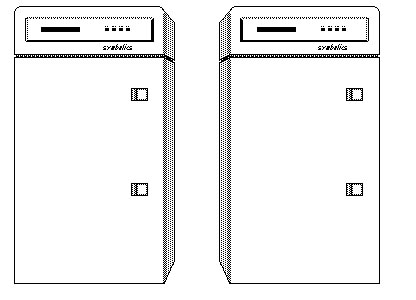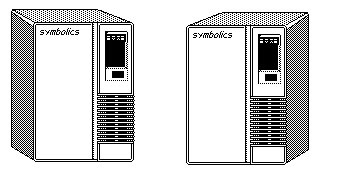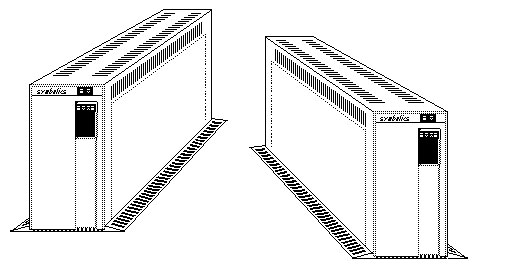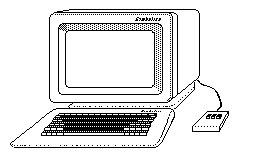Inspired by RWK’s Online Museum of Symbolics’ History. But actually a slice of oral history, which could take place almost anywhere in the computer industry in the late 1980’s.
Prologue; In the beginning …. there was the machine room. In the 60’s, it was populated by behemoths the size of small trucks. In the 70’s reduced to merely the size of a side-by-side refrigerator. In the 80’s, reduced even further to the size of compact “apartment size” ‘fridges, and finally to the insignificant dimensions of a wet-n-dry garage vacuum. At the same time machines became less power-hungry, and eventually switched from exotic power sources to ordinary wall current.
In the old, old, days, the machines were so large and expensive that tinkering by amateurs was strictly out of the question; but as the machines got smaller, cheaper, and easier to lift, it became common for any self-proclaimed knowledgeable person to do whatever seemed right and necessary to keep things running smoothly. Quite a lot generally needed to be done.
Machine rooms, in those days, were constructed with raised floors, with a foot or so of space between the “fake” floor on top and the “real” floor underneath. When brand new, this arrangement was a wonder of efficiency: bare concrete on the bottom, a neat lattice of steel conduit, power outlets of various exotic types, a regular grid of posts supporting the floor tiles, and the machines on top. Cables from the machines were stuffed down a few holes in the fake floor, and strung from point to point as necessary under the fake floor, where they were mostly out of the way. Quite a lot of cables, and quite a few different kinds.
As time went on and machines arrived, went away, or were moved, the originally neat and rational layout of cables under the floor inevitably evolved into an incredible rat’s nest of layered cables. It simply became too difficult to remove old cables from the bottom layer, so they just accumulated.
Order From Chaos
Still, chaotic though the situation under the floor was, mucking about was a remarkably safe activity, both for the muckers and the machines, because of one very simple, ironclad rule;
If you can plug in in, it’s ok to plug it in.
There is no way you can plug an Ethernet cable into a console socket, or plug a console into a power source, or even plug one kind of power cable into another kind of power outlet. They’re all shape coded so it’s physically impossible to plug something in to someplace it doesn’t belong. It may not be the right place, but it’s the right kind of place.
Now to the tale itself
The time is about 1989. The machine room at Symbolics Westwood office is in the “late maturity” state just described; and one of the worst deficiencies in the configuration was a shortage of plugs. The machines still needed a lot of power, but “ordinary” power, which had not been much in demand when the room was wired. So there was a lot of competition for places to be plugged in; and a lot of semi-legal power strips were pressed into service to provide more places.
Enter me, programmer and amateur hardware re-arranger. It’s likely that the “something wrong” in this case was that some combination of machines sharing a circuit was drawing a little too much juice, and consequently was periodically popping a breaker. This was an ideal opportunity for amateur hardware work. In any case, the solution to the problem involved stacking two machines and plugging them into different circuits in the same vicinity, to avoid blowing the breaker.
Applying my own informal rules, I turned the machine off, stacked it, and located a likely socket to plug it into; which in this case was not a regular wall or floor outlet, but a “convenience” outlet located in a vertical rack that also housed a bank of disk drives. These outlets were common throughout the machine room – you always need some place to plug in an extra tape drive, or oscilloscope. Everything was clearly normal-looking; ordinary outlets; ordinary disk drives plugged into some of the outlets; Not too many of them so, so adding one more load was probably OK.
So I plugged my machine in, and turned it on Boom! Sparks! Smoke! When I got back into my skin and investigated the wreckage, I found out two things:
The machine was totally fried (scratch $20K) The outlet I had plugged it into was wired for 220 volts, as were the disks plugged into it. I still don’t know what genius engineer prepared that rack of equipment; completely contrary to standard practice (and probably lots of wiring regulations) without even a warning label. But since then, I’m a lot more likely to call an engineer over when the hardware needs shifting.
Postscript
Plus Ça Change
Last year, my company was moving into new offices designed for the current hardware paradigm. Each cubicle is equipped with a bank of four identical phone jacks, into which you can plug either analog phones, digital phone, or 10Base-T Ethernet.
The first day, two analog modems were fried by being plugged into digital phone jacks.
Dave Dyer
Copyright 1995




